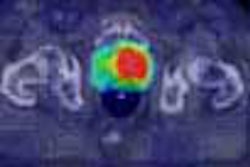Although it’s generally considered a negative, being all thumbs may not be such a bad thing. Thanks to a complex and strong ligamentous system, the thumb can withstand large axial loads because of its carpometacarpal joint, while still remaining agile.
When the thumb sustains injury, an x-ray may not be enough, according to Australian musculoskeletal imaging specialists. In a paper published in the Journal of Hand Surgery, Dr. David Connell and colleagues assessed the role of MRI for evaluating the supporting ligaments of the thumb.
"Radiographs may demonstrate soft-tissue swelling...but in the absence of a fracture, will be normal," they wrote. "Trauma to the carpometacarpal joint of the thumb probably results in a spectrum of ligamentous injury dependent on the rate and direction of the loading force" (Journal of Hand Surgery: Journal of the British Society for Surgery of the Hand, February 2004, Vol. 29:1, pp. 46-54).
The main areas of concern in this study were the anterior oblique ligament, the dorsal radial ligament, the posterior oblique ligament, and the intermetacarpal ligament. From January 2000 to May 2004, 14 patients were referred to the department of medical imaging at Victoria House Hospital in Prahran. The spectrum of injury to the base of the thumb was speculated to range from ligamentous sprain to dislocation.
The patients were examined on a 1.5-tesla Signa Horizon unit (GE Healthcare, Waukesha, WI), with the thumb in a phase-array wrist coil (ICG-Medical Advances, Milwaukee). The imaging sequences consisted of coronal and axial FSE, both through the base of the thumb carpometacarpal, as well as coronal MPGR and STIR. In addition to the patients, five healthy volunteers underwent MR exams.
Connell read the images prospectively for the original report. Co-author Dr. George Koulouris, a fellow at the hospital, then independently assessed the images, and the two reached a consensus decision.
"Disruption of the normal low signal band with hyperintensity of a ligament was felt to represent a complete tear. Incomplete disruption with some continuity of the (fibers) at the site of the injury was interpreted as a partial tear," the authors explained. If more than 70% of the fibers were torn, partial injuries were considered high grade. A 30%-70% tear indicated a moderate injury; a low-grade injury was 30% or less.
According to the results, there were 11 patients with acute injuries and three with chronic injuries. There were three complete tears and seven partial tears. In the latter group, one patient had dislocated his thumb three years prior. The MR showed advanced degenerative change of the carpometacarpal joint along with chondral loss and subcortical cyst formation.
"These ligaments appeared as continuous bands of low signal which could be followed from origin to insertion," they said.
Eight out of 14 patients underwent surgical intervention, with MR findings of a complete anterior oblique ligament disruption and a high-grade partial tear confirmed at surgery. The MRI results were also validated in two other patients treated with primary ligament repair.
The group concluded that "MR imaging has the ability to diagnose the degree of ligamentous injury and differentiate avulsions from partial tears...our radiologists had no difficulties discriminating normal from abnormal scans, although there was some discrepancy when assessing high-grade partial tears from complete tears," they wrote.
The authors stressed that the keys to successful MR thumb imaging included the use of a dedicated wrist coil to increase signal-to-noise ratio, enhance spatial resolution, and make the injury more conspicuous. Also, fast spin-echo (FSE) techniques decreased imaging time without sacrificing resolution or contrast. Finally, coronal images centered over the carpometacarpal joint will generally identify both the anterior oblique and dorsal radial ligaments.
By Shalmali PalAuntMinnie.com staff writer
March 11, 2004
Related Reading
MRI, US make sense of disorganized scar tissue in PTTL injuries, October 29, 2003
Just (over) Do It! Imaging pegs overuse injuries in specialty sports, October 8, 2003
MR categorizes acute hamstring injuries for pre-op assessment, September 29, 2003
The role of MRI and US in acute hamstring injuries: A preliminary report, July 22, 2002
Copyright © 2004 AuntMinnie.com



.fFmgij6Hin.png?auto=compress%2Cformat&fit=crop&h=100&q=70&w=100)




.fFmgij6Hin.png?auto=compress%2Cformat&fit=crop&h=167&q=70&w=250)











